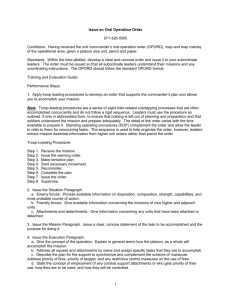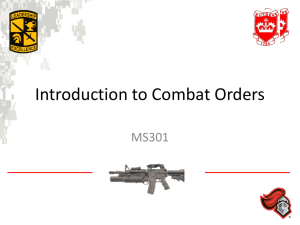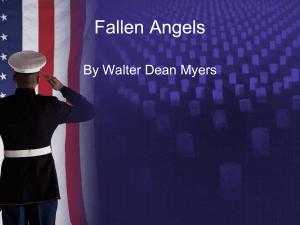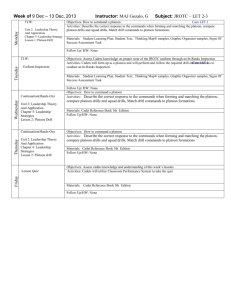Garrison Operations Leadership Help Sheet
advertisement
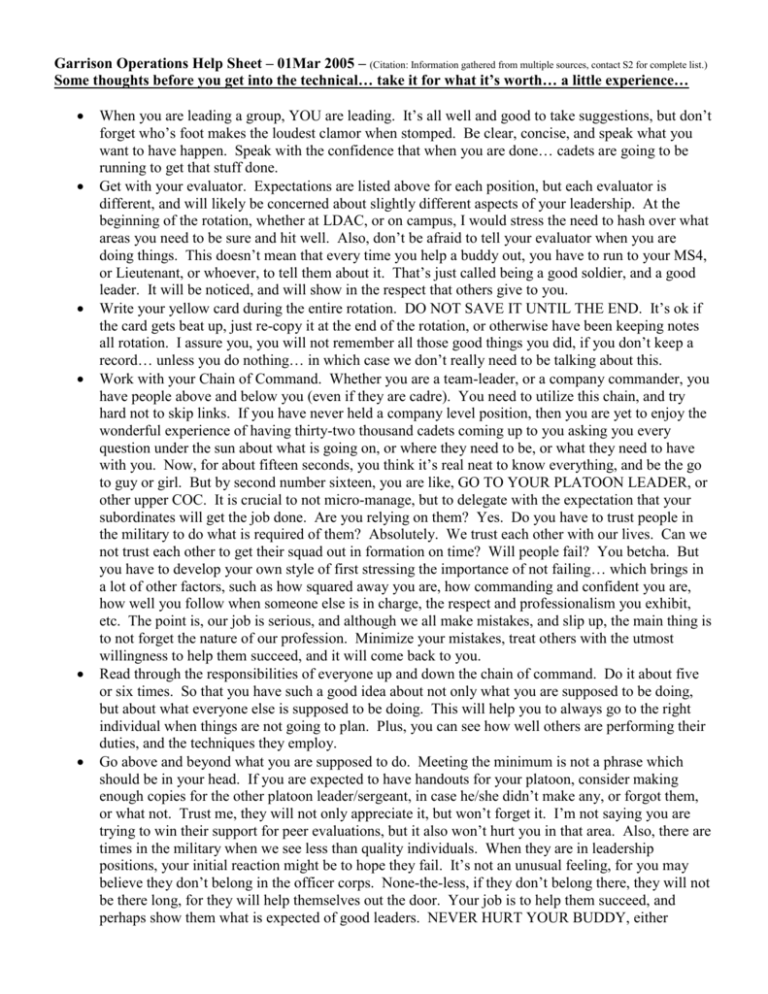
Garrison Operations Help Sheet – 01Mar 2005 – (Citation: Information gathered from multiple sources, contact S2 for complete list.) Some thoughts before you get into the technical… take it for what it’s worth… a little experience… When you are leading a group, YOU are leading. It’s all well and good to take suggestions, but don’t forget who’s foot makes the loudest clamor when stomped. Be clear, concise, and speak what you want to have happen. Speak with the confidence that when you are done… cadets are going to be running to get that stuff done. Get with your evaluator. Expectations are listed above for each position, but each evaluator is different, and will likely be concerned about slightly different aspects of your leadership. At the beginning of the rotation, whether at LDAC, or on campus, I would stress the need to hash over what areas you need to be sure and hit well. Also, don’t be afraid to tell your evaluator when you are doing things. This doesn’t mean that every time you help a buddy out, you have to run to your MS4, or Lieutenant, or whoever, to tell them about it. That’s just called being a good soldier, and a good leader. It will be noticed, and will show in the respect that others give to you. Write your yellow card during the entire rotation. DO NOT SAVE IT UNTIL THE END. It’s ok if the card gets beat up, just re-copy it at the end of the rotation, or otherwise have been keeping notes all rotation. I assure you, you will not remember all those good things you did, if you don’t keep a record… unless you do nothing… in which case we don’t really need to be talking about this. Work with your Chain of Command. Whether you are a team-leader, or a company commander, you have people above and below you (even if they are cadre). You need to utilize this chain, and try hard not to skip links. If you have never held a company level position, then you are yet to enjoy the wonderful experience of having thirty-two thousand cadets coming up to you asking you every question under the sun about what is going on, or where they need to be, or what they need to have with you. Now, for about fifteen seconds, you think it’s real neat to know everything, and be the go to guy or girl. But by second number sixteen, you are like, GO TO YOUR PLATOON LEADER, or other upper COC. It is crucial to not micro-manage, but to delegate with the expectation that your subordinates will get the job done. Are you relying on them? Yes. Do you have to trust people in the military to do what is required of them? Absolutely. We trust each other with our lives. Can we not trust each other to get their squad out in formation on time? Will people fail? You betcha. But you have to develop your own style of first stressing the importance of not failing… which brings in a lot of other factors, such as how squared away you are, how commanding and confident you are, how well you follow when someone else is in charge, the respect and professionalism you exhibit, etc. The point is, our job is serious, and although we all make mistakes, and slip up, the main thing is to not forget the nature of our profession. Minimize your mistakes, treat others with the utmost willingness to help them succeed, and it will come back to you. Read through the responsibilities of everyone up and down the chain of command. Do it about five or six times. So that you have such a good idea about not only what you are supposed to be doing, but about what everyone else is supposed to be doing. This will help you to always go to the right individual when things are not going to plan. Plus, you can see how well others are performing their duties, and the techniques they employ. Go above and beyond what you are supposed to do. Meeting the minimum is not a phrase which should be in your head. If you are expected to have handouts for your platoon, consider making enough copies for the other platoon leader/sergeant, in case he/she didn’t make any, or forgot them, or what not. Trust me, they will not only appreciate it, but won’t forget it. I’m not saying you are trying to win their support for peer evaluations, but it also won’t hurt you in that area. Also, there are times in the military when we see less than quality individuals. When they are in leadership positions, your initial reaction might be to hope they fail. It’s not an unusual feeling, for you may believe they don’t belong in the officer corps. None-the-less, if they don’t belong there, they will not be there long, for they will help themselves out the door. Your job is to help them succeed, and perhaps show them what is expected of good leaders. NEVER HURT YOUR BUDDY, either intentionally, or by simply being complacent. Strive to help others succeed, without trying to be obvious that you are helping them. I promise, somewhere, somehow, your fellow cadets will see it, and they won’t forget it, even if that cruddy cadet you helped doesn’t strive with you. Always try to build in a few minutes of spare time in your timeline, although don’t suggest to the group that you are in charge of, that that is what you have done. Make them believe that whatever it is that you need done by a certain time, darn well better be done at that time. No matter what, things are gonna get jacked up from time to time, and if you’ve covered your ass by building in a few minutes so that you aren’t late, you not only keep yourself from looking bad, but you make your upper COC look good, and they won’t forget that. Plus, it’s just the right thing to do. And we do what is right, even when no one is looking… right? It’s no use barking orders if you don’t look the part. If your uniform is jacked up, you have more difficulty making people believe that you are serious, and that this is important to you. The excuse… “well they are just gonna get dirty anyway” isn’t viable. You never know when you could get away with something a hundred times, but this time, you didn’t shine your boots, and the TAC has a surprise inspection, and there you are, with yesterdays “range-boots” still on. Square yourself away! Team building is essential. Do people like time off… yes. But remember that it is your responsibility to make your element look good. Try to provide them time with some of your own training mixed in. Make time-off a reward for getting through the things you need done. You are leading… if you don’t look like you care, then no one else is going to. Be motivated, don’t embarrass people in front of groups, and to be a good leader, we first have to be good followers. DUTIES AND RESPONSIBILITIES COMPANY COMMANDER: Responsible for the success and failures of the unit, accountability of all personnel and equipment, uniformity of the unit, maintaining the Regimental time schedule and specific instructions. _____ NEVER BE LATE-Take charge of the situation if you’re going to be late. _____ Issue Orders to the unit to execute the daily training plan, include rehearsals after the order and ensure the plan covers the entire day; IT MUST HAVE A RECOVERY PLAN! _____ WARNO – issue on the day you receive the OPORD _____ OPORD - issue after leaders’ recon (NLT 36 hours after Reg OPORD) _____ FRAGO – issue within 1 hour of receipt (night before position begins) _____ Find out who the PLs, XO, 1SG are and where they billet (4 days out) _____ Ensure the XO goes on the leaders’ recon with cadre (2 days out) _____ Task XO and 1SG to supervise and inspect activities: _____ Chow line, Weapons draw, Vehicle loading, Equipment loading etc… _____ Know how many people are: (know the number of cadets assigned to the Company) _____ Present for duty (from 1SG after 1st formation; update every couple of hours) _____ On sick call (from 1SG after 1st formation; update every couple of hours) _____ On each vehicle for movement (task PLs with telling you this prior to movement) _____ Ride the first vehicle moving to the training site (1SG on 2nd, XO on 3rd) _____ Report to OIC immediately upon arrival to get instructions _____ Get unit by Platoons into the bleachers (stay standing) _____ Report to OIC with salute, # of cadets, Company name and motto _____ Instruct unit to take seats with motto- sound good; simple mottos are best _____ Thank the OIC prior to getting on vehicles for movement to the Regimental area ** Soldiers do what leaders check** EXECUTIVE OFFICER: Second in command (2IC), responsible for coordinating mess, and transportation; is the safety officer and must brief a safety motto at morning formation (brief it at the OPORD using a neat chart). 2IC knows what the commander knows and is prepared to assist or take over. _____ Attend the CO’s OPORD, ensure all PLs and 1SG are present _____ Coordinate chow times with D-FAC SGT _____ Coordinate with Regimental Cadre for a leaders’ recon of the training site _____ Draw a sketch of the site and a strip map of the route (include Grid Coordinates) _____ Know how many people are: (know the number of cadets assigned to the Company) _____ Present from duty (from 1SG after 1st formation; update every couple of hours). _____On sick call (from 1SG after 1s5t formation; update every couple of hours) _____On each vehicle for movement _____ Mark each vehicle with plt marking #s (during formation) _____ Ride the third vehicle moving to the training site _____ Coordinate the location of the medics throughout the day _____ Coordinate with the 1SG for details (KP, Police, CQ, etc…) _____ Use squads for details to maintain unit integrity _____ Review your plans with the Regimental XO and seek his advice in problem areas. ** You are a big-wig, make things happen** DUTIES AND RESPONSIBILITIES FIRST SERGEANT: Responsible for personnel accountability, control of admin movements and formations of the company, adherence to the commander’s times schedule, police of the company area and strict enforcements of individual uniformity throughout the company. ____Attend the CO’s OPORD, ensure all PLs and the XO are present; rehearse PSG’s for formations. ____ Rehearse the formation with PSGs; Receive the report at the first formation: ____ Get with PSGs prior to formation and get accountability; ensure numbers are correct and match what is standing in formation. ____ Turn in the personnel report to the admin NCO (cadre) immediately after formation. ____ Turn the formation over to the XO for the safety brief ____ If not required or after, put out brief instructions (loudly) for in-rank inspections, chow, bus loading, etc…and tell PSGs to take charge of their platoons. ____ If the unit is moving as a company, you control the formation and call cadence (loudly) ** FM 22-5: “Close on leading platoon” is the only command you give prior to the unit moving as a whole (tell PSGS ahead of time if you do this- They say: 1st Plt “Standfast”, 2nd-4th Plts “Forward, March; Mark Time, March; Platoon, Halt”) ____ Coordinate with the XO for details and the time and place they report (KP, CQ, etc.) ____ Check and ensure they are at the required place on time and in the right uniform ____ Check police and security of the company area (billets) or areas specified by cadre. ____ Know how many people are: (know the number of cadets assigned to the Company ____ Present for duty (from PSGs at 1st formation ; update every couple of hours) ____ On sick call (from PSGs at 1st formation ; update every couple of hours) ____ On each vehicle for movement ____ Ensure the commander and XO know this information without have to ask ____Ride the second vehicle moving to the training site ____ Supervise chow and bus loading to ensure the commander’s time schedule is met ** No One leaves or returns to training without you knowing –Always have Accountability** PLATOON LEADER: Prepares and issues all orders for the platoon to execute the day’s training: controls and supervises the execution of administrative and tactical operations; ensures higher HQ is updated on platoon personnel / equipment status at all times; attends squad orders if possible. ____ NEVER BE LATE ____ Issue WARNO ASAP after company order is received; Task for: ____ Recorder to draw sketch of training area and put time line on butcher paper ____ PSG to put out details for the night (Fire-guard roster and cleaning requirements) ____ Issue OPORD NLT 1.5 hours after WARNO (if PTO time is available ask the PTO what they want to do- if nothing, give a recommendation of training to be conducted by SLs or PT). Include rehearsals after the order and ensure the plan covers the entire day. ____ Issue FRAGOs as information becomes available (ensure information is disseminated ) ____ Keep company commander informed of personnel & equipment changes (ASAP) ____ Ensure billets are squared away and that all platoon requirements are met **Be in charge; keep the platoon informed and excited; You are responsible** DUTIES AND RESPONSIBLITIES PLATOON SERGEANT: Supervises the execution of the platoon leader’s order; ensure the SOP is properly completed for cleaning; maintains accountability of all personnel and equipment; ensures higher HQ is updated on platoon personnel and equipment status at all time; listen to the squad orders as much as possible. ___ NEVER BE LATE ___ Assist the PL as required in preparation of the OPORD (para. 4-use visual aids) ___ Ensure fire guard is posted and works on cleaning requirements all night ___ Supervise morning cleaning (rotate details so one squad doesn’t always get latrines) ___ Have exact accountability at all times (# assigned, # present, sick call by name, etc.) ___ Insure you get with TACs first thing AM with this information; update as necessary ___ Control all formations (don’t wait for someone who is late- leave a team leader to escort) ___ Sound off with clean, crisp cadence ___ After chow, let SLs take charge of moving their squads back to the billets (rotate to chow to ensure you have the time to clean properly) ___ Use the cleaning list in your book ___ Supervise inspections by doing the SLs first, then let them inspect their squads. ___ Supervise bivouac preparation (ensure females are paired together) ___ Maintain security during platoon tactical operations ___ Ensure all details happen on time and in orderly manner (task squads or teams not individuals except for chow line runner) ___ Ensure billets (wall/foot lockers, windows, fire doors) are secured and keys turned in ___ Count personnel onto vehicles and report that number to 1SG ___ Keep everything possible dress-right-dress ** Delegate and supervise jobs; help but demand cooperation within the platoon ** SQUAD LEADER Responsible for the accountability of personnel and equipment; ensures all squad areas of responsibility are squared away; assist the PSG/PL as necessary; conducts PCI of all squad members in preparation for the training day. ___ Issue WARNO ASAP (appoint the best people TLs) ___Issue OPORD within 30 minutes of platoon order (use PLs visual aid) ___PCI equipment the night before training ___Ensure everyone conducts personal hygiene the night before training ___Get started on cleaning ASAP (at night if possible)- if you finish early, help others (you clean your area and supervise others by helping them) ___At formation know accountability by name (maintain thru day) ___ Inspect entire squad for uniformity ___ Ensure females get the word on everything ___Keep everyone informed at all times **Direct, supervise and help; be the best** PERSONNEL ACCOUNTABILITY # ASSIGNED: ______ # PRESENT: _______ # SICK CALL:___________ NAMES: _____________________ _____________________ _____________________ _____________________ _____________________ _____________________ _____________________ _____________________ ALLERGIC TO BEE STINGS Names: _____________________ ____________________ _____________________ _____________________ _____________________ _____________________ NON/WEAK SWIMMERS: NAMES: ___________________W/N ___________________W/N ___________________W/N ___________________W/N Hot/Cold Weather Injuries: _____________________ _____________________ _____________________ _____________________ _____________________ # HOSPITAL___________ NAMES: ______________________ ______________________ ______________________ ______________________ Miscellaneous: _______ _____________________ _____________________ _____________________ _____________________ _____________________ Know daily if you are in a leadership position at Platoon level; if at Company level, have PSG’s provide the numbers to the 1SG but require all PSGs to carry this information (by name) to training and to update you as changes in status occur. BARRACKS INSPECTION CRITERIA ____ FLOORS ______ Floors dusted and mopped or buffed ______ Floor underneath bunks is dust free ______ Stairs swept inside and outside steps ______ Base Boards clean ____ LATRINE ______ Shower walls and floor clean and dry with no soap residue ______ All soap racks clean and dry ______ Floors swept, mopped and dry (drain covers clean) ______ Commodes clean inside and out with seats up ______ Sinks clean and dry with no residue ______ Mirrors clean with no streaks ______ Urinals clean and free of trash with deodorant bar present ______ Toilet tissue at least ¼ full for each seat ______ Utility sink clean and pipes dusted ______ Sink shelf clean with paper towels present (centered or by each sink) ______ Sponges rinsed and cleaned ______ Trash cans empty and lined with a bag _____OUTSIDE ______ Stairs swept ______ Policed and raked ______ Mop shed closed and secured (IAW SOP) _____ BUNK AREA ______ Made properly; no wrinkles, dust covers on, correct corners ______ Name tape is uniform on all bunks ______ Shoe display is uniform (aligned) and all are dusted and shined (boots) ______ All foot/wall lockers are aligned and have name tapes; dust free ______ All metal framing is dusted on bunks ______ Laundry bags and wash cloth/towel are uniform on all bunks IAW SOP _____WINDOWS ______ All windows and ledges/ sills clean and dust free ______ All painted windows remain closed at all times ______When open, all windows are dressed right and screens are in place ______SECURITY ______ Fire escape door latched from inside while building is unoccupied ______ Front and back door locked while building is unoccupied ______ All foot lockers and wall lockers secured with a lock ______LIGHTS ______Fire lights off at dawn and on at dusk ______All lights free of dust and off when the building is unoccupied ______All lights work or get a work order from the PTNCO (follow-up ASAP) _____ MISCELLANEOUS ______ All water pipes and rafters dusted ______ Fire extinguishers dusted and functional (look at pressure indicator) ______ Mops and buckets clean and hung IAW SOP ______ Dust pans and brooms clean and stored IAW SOP ______ Washer & Dryer clean (dry) and no soap residue (area behind and underneath clean ______Dryer filter clean and vent hooked up to dryer back and wall ______ All appliances unplugged when building is unoccupied ______ Trash cans empty and lined with a bag ______ Bulletin board edges dust free and papers neat; current days training schedule posted ______ Supplies required for cleaning requisitions thru PTNCO ______ ASK if the TACs want their office cleaned (sweep, dust) ______ Cadet office clean with materials neatly stacked or stored. ****Key Techniques for Success**** Make the fire guards work because this is too much to do the morning of training No one should have to shave the morning of training When the time is posted for latrine cleaning, no one uses it except for emergencies Do everything you can before lights out Post this list on your leadership days on butcher paper and brief it in subunit tasks…make SLs initial after they inspect something…double check [It is only 32 days so suck it, relax, and just go with it!] Garrison Operations Warning Order Format 1. SITUATION a. Enemy (use what higher gave you): b. Friendly (higher’s mission statement, next 2 levels up): 2. MISSION (your mission statement; repeat it): 3. GENERAL INSTRUCTION a. Chain of Command (by Name and Billet number/floor): b. Special Teams (maintain Sqd/Tm integrity for details – Police call etc.as required) c. Uniform and equipment common to all (equipment and uniform necessary – protractors): d. Special Equipment (duffle bag-with packing list, special markings, MILES etc…): e. Time Schedule: 1. Time, place, attendees for OPORD: 2. Inspection time by subordinates and you: 3. Recon time (if applicable): 4. Rehearsal times: 5. Lights out time: _______; Wake up; ______; First Formation:_______; Movement to tng: _______; Return time: ______; Chow (B,L,D): _________/________/________ 4. SPECIAL INSTRUCTIONS: a. Subordinate Leaders; as necessary –task for: 1. Recorder – posts time schedule and cleaning list while you prep the OPORD 2. Chow runner, CQs, fire guard, cleaning detail during chow, etc… 3. Task for recon requirements or quartering parties/platoon guides (Co level) 4. Rehearsal priorities What are your questions? Garrison Operations Order Ensure all required cadets are present (Take Roll) I’m cadet ___________ from Syracuse University, the “Stalwart” Battalion, and I am the ________ (position) for _______(date). This is the OPORD; hold all questions until the end. Everyone needs paper, something to write with and prepare to copy. Weather (today and tomorrow): HI_____;LOW_____;% Precipitation______: ____________________________________________________ HI_____;LOW_____;% Precipitation______: ____________________________________________________ Effect on our operation is (Hot /Cold injuries as applicable; rain makes it slippery at training site and while loading or unloading transportation): 1. SITUATION: a. Enemy forces (none; or low morale, not paying attention to detail and not watching out for your buddy. b. Friendly Forces (higher’s mission statement, next 2 levels up): c. Attachments and Detachments (none): 2. MISSION (use highers but specific to your unit; repeat it) 3. EXECUATION: Commanders Intent: a. Concept of the Operation (use a drawing on butcher paper to give an exact overview of the key events by showing the training site and route; show the formation area for the site orientation and then the route back to the Regimental area or Bivouac Site) We will execute the day in four phases: The phases are : Phase 1 – Troop leading procedures from now until morning; Phase 2 – Wake-up, First Formation – for accountability, Cleaning, Breakfast and movement formation; Phase 3 – Conduct of training; Phase 4 – Return from training, recover and preparation for follow on training. 1. Maneuver (discuss each of the phases in detail- give Mission Essential Tasks) Phase 1: Phase 2: Phase 3: Phase 4: 2. Fires: Not Applicable b. Tasks to Maneuver Unit: (give cleaning requirements, bus loading instructions and/or, order of march, order of drawing/turning in weapons or laundry, and order for chow to each unit) 1st (plt/sqd) 2nd (plt/sqd) 3rd (plt/sqd) 4th (plt/sqd) c. Coordinating Instructions: (post the time schedule on butcher paper and review Mission Essential Times/tasks – do not read to them!) SAFETY: Use the buddy system to watch for weather injuries; drink ____canteens of water per hour; do not mess with the wildlife; stop and report unsafe acts; everyone is a safety officer. 4. SERVICE SUPPORT (get exactly from higher – add but do not take away) a. Ration cycle: b. Uniform (specify exactly what goes on LBE and in pockets; use a “uniformed” soldier as the example; if the list is long include it as a visual aid). 5. COMMAND AND SIGNAL: a. Chain of command (your unit & higher CO, XO, 1SG – Give Billet number/Floor): b. Signal: (NA or what higher gave you) The time is now _______; what are your questions? Do a brief-back by asking questions. When you are leading, whether in the field, OR IN A GARRISON ENVIRONMENT, don’t forget… 1. Troop Leading Procedures: The process a leader goes through to prepare a unit to accomplish a mission (Max planning time for subordinates). They begin with an alert of an upcoming mission, or a change in the current mission. There is an 8-Step procedure in which only steps 1 and 2 must be followed in sequence. Steps 3-8 are usually accomplished concurrently but must not be omitted to ensure that nothing is left out of planning and preparation for the mission. They are continuously updated as more information becomes available (FRAGOs). STEP 1: Receive the mission STEP 5: Reconnoiter STEP 2: Issue a warning order STEP 6: Complete the plan STEP 3: Make a tentative plan STEP 7: Issue the complete order STEP 4: Start necessary movement STEP 8: Supervise 2. After Action Review. a. What was the mission or training objective?_______________________________ _________________________________________________________________________ b. What was the plan to accomplish mission?________________________________ _________________________________________________________________________ c. What actually happened?______________________________________________ _________________________________________________________________________ d. What was done well and needs to be sustained?____________________________ _________________________________________________________________________ e. What was not done well and needs improvement?__________________________ _________________________________________________________________________
